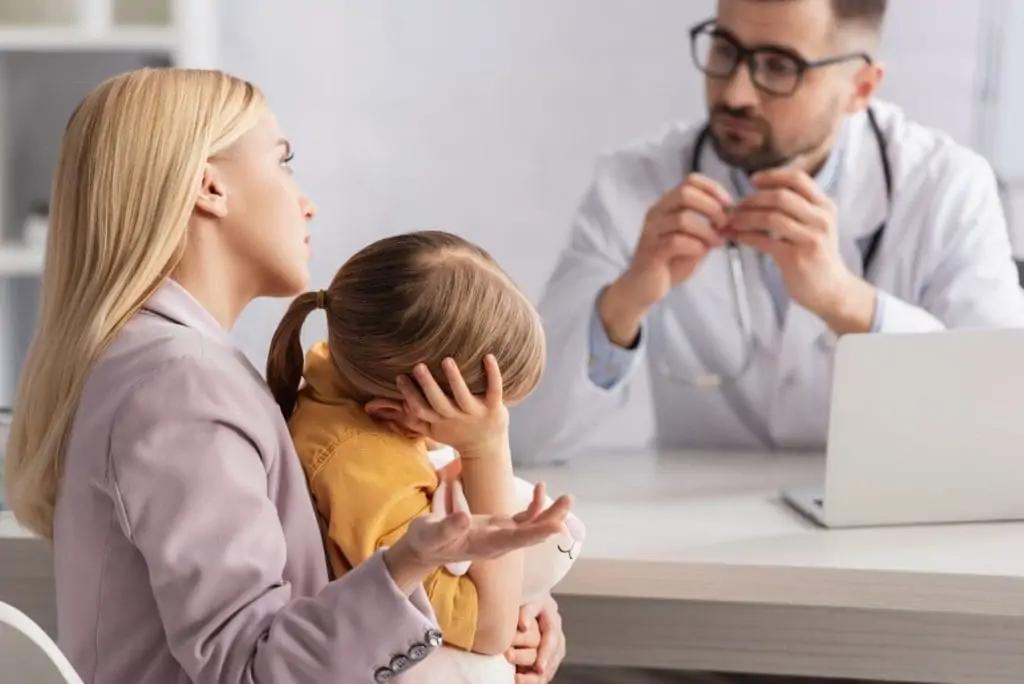
Can Chiropractic Care Relieve Growing Pains?
- posted: Nov. 18, 2021
Everyone has experienced growing pains. That deep, aching feeling in your limbs that seemingly comes from nowhere and can last for hours or days. Most of us have been told that these aches and pains are just a part of growing up and that they’ll work themselves out eventually. Is this true? What are growing pains? How can you know whether what your child is experiencing is a growing pain or something more? Are there options for treatment?

What Are Growing Pains?
Growing pains are common among children and adolescents (though they can appear in adults, too). Typically, they are deep, aching pains felt in the limbs (primarily the legs) and lower back. The pain usually lasts less than two weeks, presents itself late in the day or during the night, and is often accompanied by stiffness and soreness.
Formerly, it was thought that these pains were caused by growth spurts, as they typically appear in children and adolescents; however, though these pains are called growing pains, there’s no evidence that bouts of rapid growth (or growth rate at all) causes the pain.
Increasingly, evidence suggests that this muscle pain is associated with increased physical activity (resulting in overuse of the muscles) and other biomechanical issues such as hypermobility of the joints and flat feet. Dr. Kyle Smerglia, of Smerglia Chiropractic, explains, “The actual pain isn’t necessarily coming from the bones growing, or anything along those lines. A lot of times the musculature has to catch up to those bones that are growing.When those muscles are trying to catch up, a lot of times they’re gonna have some aches and pains.”
Are There Good and Bad Growing Pains?
Knowing the cause of these pains helps us understand that there really aren’t ‘good’ or ‘bad’ growing pains. That said, it’s helpful to understand in better detail what the symptoms and experience of growing pains are so that you can differentiate between them and more serious ailments.
Generally, growing pains appear on both sides of the body. In addition to the legs and lower back, it’s not unusual for growing pains to appear in the thighs, shins, calves, behind the knees, or even in and around the pelvis (hence the lower back pain often associated with growing pains). Sometimes, growing pains occur in the arms, but these are almost always accompanied by leg pain as well. Because these pains aren’t associated with growth but rather overuse of muscles, they can occur at any age. “It’s a muscle response to physical activity and being a child and growing up,” Dr. Smerglia adds. “There can be symptoms that feel like growing pains that can be something else. And that would be more of a bad growing pains type.”
The intensity of the pain can range from mild to severe. The frequency varies, too. Some experience the pain daily where many others experience them intermittently, with pain-free intervals ranging from days to months. Some sufferers can experience such sharp or severe pain that it wakes them up at night but is gone altogether by morning.

When Should Parents Be Concerned About Growing Pains?
Growing pains are usually harmless, but in some cases similar pains may indicate a more severe problem. If your child is having pain that is persistent or doesn’t go away by the morning, it may be more than growing pains or muscle fatigue. See a medical doctor if your child has joint pain, pain that interferes with normal daily activities, pain related to an injury or unusual stress, pain accompanied by redness, swelling, fever, weakness, loss of appetite or rash, or pain that occurs in only one side of the body, as these may be signs of a more serious condition.
“If it’s a persistent thing. Growing pains are normally gonna come and go over a period of time. It’s going to be the parents’ decision to take them to go get that physical exam. Anything that seems weird or not normal is probably worth taking your child to go get it checked out. The worst thing that happens is he gets a clean bill of health,” Dr. Smerglia explains.
How Can Pediatric Chiropractic Care Provide Relief for Growing Pains?
Growing pains can be treated in a number of ways. Massage, stretching, applying a heating pad to the affected area, taking a warm bath after a lot of physical activity, and even over-the-counter pain relievers such as Tylenol to help ease the pain so that your child can sleep are all viable treatment options. Additionally, the use of orthotics for those that have flat feet and physical therapy aimed at strengthening joints for sufferers with hypermobility can contribute to pain relief over the long-term.
As for chiropractic adjustments, the degree to which they relieve growing pains varies. Manipulative therapy has the most significant impact when the experience of growing pains contributes to poor posture or adds additional stress to the joints or spinal column. We often try to compensate when we experience pain (for example, you may limp after a fall to limit the pain you feel when walking). When we compensate like this, we add stress to other joints and change our posture which can lead to both spinal misalignment and pelvic misalignment, ultimately yielding more pain throughout the body. Chiropractic treatment can help alleviate these pains.
Additionally, there is some evidence that growing pains are associated with the pain threshold of the sufferer (meaning those that experience growing pains may have an overall lower threshold for pain than their peers). Children suffering from growing pains are more likely to experience headaches and abdominal pain than others. Regular visits to your pediatric chiropractor can help to manage these headaches and other physical or chronic pain your child may be experiencing.
Conclusion
Growing pains are a real thing. They’re usually harmless but can indicate something more serious. The good news is that there are many treatment options available to help with growing pains including chiropractic care. Have questions about the pain your child is experiencing? Reach out to the experts at Smerglia Chiropractic for more information today.
Additional Resources:
https://my.clevelandclinic.org/health/diseases/13019-growing-pains

Can Chiropractic Care Relieve Growing Pains?
- posted: Nov. 18, 2021
Everyone has experienced growing pains. That deep, aching feeling in your limbs that seemingly comes from nowhere and can last for hours or days. Most of us have been told that these aches and pains are just a part of growing up and that they’ll work themselves out eventually. Is this true? What are growing pains? How can you know whether what your child is experiencing is a growing pain or something more? Are there options for treatment?

What Are Growing Pains?
Growing pains are common among children and adolescents (though they can appear in adults, too). Typically, they are deep, aching pains felt in the limbs (primarily the legs) and lower back. The pain usually lasts less than two weeks, presents itself late in the day or during the night, and is often accompanied by stiffness and soreness.
Formerly, it was thought that these pains were caused by growth spurts, as they typically appear in children and adolescents; however, though these pains are called growing pains, there’s no evidence that bouts of rapid growth (or growth rate at all) causes the pain.
Increasingly, evidence suggests that this muscle pain is associated with increased physical activity (resulting in overuse of the muscles) and other biomechanical issues such as hypermobility of the joints and flat feet. Dr. Kyle Smerglia, of Smerglia Chiropractic, explains, “The actual pain isn’t necessarily coming from the bones growing, or anything along those lines. A lot of times the musculature has to catch up to those bones that are growing.When those muscles are trying to catch up, a lot of times they’re gonna have some aches and pains.”
Are There Good and Bad Growing Pains?
Knowing the cause of these pains helps us understand that there really aren’t ‘good’ or ‘bad’ growing pains. That said, it’s helpful to understand in better detail what the symptoms and experience of growing pains are so that you can differentiate between them and more serious ailments.
Generally, growing pains appear on both sides of the body. In addition to the legs and lower back, it’s not unusual for growing pains to appear in the thighs, shins, calves, behind the knees, or even in and around the pelvis (hence the lower back pain often associated with growing pains). Sometimes, growing pains occur in the arms, but these are almost always accompanied by leg pain as well. Because these pains aren’t associated with growth but rather overuse of muscles, they can occur at any age. “It’s a muscle response to physical activity and being a child and growing up,” Dr. Smerglia adds. “There can be symptoms that feel like growing pains that can be something else. And that would be more of a bad growing pains type.”
The intensity of the pain can range from mild to severe. The frequency varies, too. Some experience the pain daily where many others experience them intermittently, with pain-free intervals ranging from days to months. Some sufferers can experience such sharp or severe pain that it wakes them up at night but is gone altogether by morning.

When Should Parents Be Concerned About Growing Pains?
Growing pains are usually harmless, but in some cases similar pains may indicate a more severe problem. If your child is having pain that is persistent or doesn’t go away by the morning, it may be more than growing pains or muscle fatigue. See a medical doctor if your child has joint pain, pain that interferes with normal daily activities, pain related to an injury or unusual stress, pain accompanied by redness, swelling, fever, weakness, loss of appetite or rash, or pain that occurs in only one side of the body, as these may be signs of a more serious condition.
“If it’s a persistent thing. Growing pains are normally gonna come and go over a period of time. It’s going to be the parents’ decision to take them to go get that physical exam. Anything that seems weird or not normal is probably worth taking your child to go get it checked out. The worst thing that happens is he gets a clean bill of health,” Dr. Smerglia explains.
How Can Pediatric Chiropractic Care Provide Relief for Growing Pains?
Growing pains can be treated in a number of ways. Massage, stretching, applying a heating pad to the affected area, taking a warm bath after a lot of physical activity, and even over-the-counter pain relievers such as Tylenol to help ease the pain so that your child can sleep are all viable treatment options. Additionally, the use of orthotics for those that have flat feet and physical therapy aimed at strengthening joints for sufferers with hypermobility can contribute to pain relief over the long-term.
As for chiropractic adjustments, the degree to which they relieve growing pains varies. Manipulative therapy has the most significant impact when the experience of growing pains contributes to poor posture or adds additional stress to the joints or spinal column. We often try to compensate when we experience pain (for example, you may limp after a fall to limit the pain you feel when walking). When we compensate like this, we add stress to other joints and change our posture which can lead to both spinal misalignment and pelvic misalignment, ultimately yielding more pain throughout the body. Chiropractic treatment can help alleviate these pains.
Additionally, there is some evidence that growing pains are associated with the pain threshold of the sufferer (meaning those that experience growing pains may have an overall lower threshold for pain than their peers). Children suffering from growing pains are more likely to experience headaches and abdominal pain than others. Regular visits to your pediatric chiropractor can help to manage these headaches and other physical or chronic pain your child may be experiencing.
Conclusion
Growing pains are a real thing. They’re usually harmless but can indicate something more serious. The good news is that there are many treatment options available to help with growing pains including chiropractic care. Have questions about the pain your child is experiencing? Reach out to the experts at Smerglia Chiropractic for more information today.
Additional Resources:
https://my.clevelandclinic.org/health/diseases/13019-growing-pains
